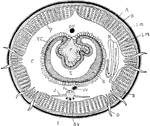Clipart tagged: ‘Peritoneum’

Cells from the Abdominal Lining
Flat cells from the surface of the lining membrane of the abdomen (peritoneum). Labels: a, cell-body;…

Earthworm
"Transverse section of earthworm. A., Cuticle; B., epidermis; C.M., circular muscles; L.M., longitudinal…

The Peritoneum
The peritoneum is a large serous membrane, which forms in the male a closed sac, the parietal layer…

The Peritoneum
Diagram of the peritoneum, a serous membrane covering all the contents of the abdominal cavity. Labels:…